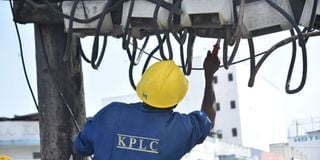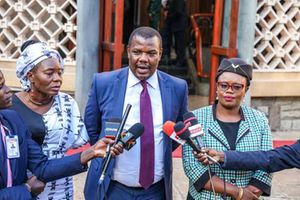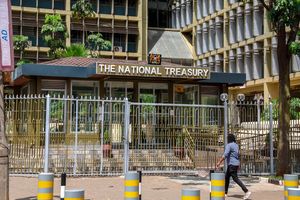Inside World Bank reforms push at KPLC

A Kenya Power employee carries out repairs on Haile Selassie Road, Mombasa.
An impending Sh41 billion World Bank financing deal for Kenya Power and Lighting Company (KPLC) has revealed deep governance and financial reforms targeted at restoring business viability at the limping giant firm.
A scheduled Programme for Results (PforR) tied to the concessional debt by the International Development Association (IDA) — a member of the World Bank — revealed a widespread reform demands even as KPLC readies itself for a fresh round of electricity supply at the grassroots through the Last Mile Connectivity (LMC).
Under the proposals, governance systems are set to be shaken up to improve oversight by minority shareholders and independent board members as well as the competitive appointment of both executives.
“The programme will support policy actions aimed at ensuring long-term planning, institutional stability and capacity, and improved governance at KPLC, including a timely competitive selection of the Managing Director, and the election of three positions of independent directors to the Board nominated by the minority private shareholders to strengthen the Board’s objectivity and ensure the right balance between the social and commercial objectives of the utility,” the World Bank reveals in the PforR.
KPLC last week picked John Siror as its substantive managing director after a two-year wait with an acting boss.
The recruitment of Dr Siror, a former general manager for systems operations at the State-owned Kenya Electricity Transmission Company (Ketraco) followed a selection by consultancy firm Deloitte East Africa. And with the CEO position now filled, the World Bank’s reforms demand list now means that attention is shifts to board appointments.
“Several other governance strengthening measures will be supported under the programme, which includes, enhancing transparency in KPLC Board appointments,” the the World Bank says in its reform plan.
Some of the parameters listed are disclosure of the qualification and skills-mix requirements of new directors to be appointed every year; updating of various governance documents; a succession plan for senior management and talent pool development to build a pipeline for senior management positions.
Joy Brenda Masinde, an advocate of the High Court of Kenya, chairs the Kenya board. Others on the board are Dr Siror, Treasury Cabinet Secretary Njugunga Ndung’u, Alex Wachira, Energy Principal Secretary, Duncan Ojwang, the Dean of Africa Nazarene University School of Law, and Kairo Thuo, a lawyer and accountant by profession.
Humphrey Muhu, a non-executive director, Benson Mwakina(alternate Director to the Energy PS), Albert Mugo, Logan Christi Hambrick, Veska Kangogo and Imelda Bore, the KPLC Company Secretary are also on the board.
Davis Chirchir is the Energy Cabinet Secretary.
The Bank’s reforms also eye a turnaround of revenue collection and business efficiency in an attempt to attract private investors.
“The strategy will be focused on key strategic areas including business operational efficiency, loss reduction, supply reliability, revenue collection, improved customer experience, innovative business growth, and corporate sustainability,” the World Bank says, adding that they will “pave the way for greater private participation in shareholding in KPLC”.
Repaying the billions of shillings it owes KenGen, Independent Power Producers (IPPs) and other power suppliers would also be a priority as well as a push for reversion to cost-reflective tariff principles.
A recent report by Auditor-General Nancy Gathungu revealed Sh2.3 billion in disputed payables allegedly owed by Kenya Power to KenGen, Ketraco, and Rerec.
“It will mitigate KPLC’s off-taker risk, critical for private sector-led renewable energy generation, by reducing arrears to KenGen, IPPs, and other power suppliers. The programme will support the sector to revert to cost-reflective tariff principles and reduce the unsustainable fiscal burden on the government while achieving affordability through improved planning, timely GoK (Government of Kenya) transfers to eliminate the need for commercial funding of social objectives, transmission, and distribution loss reductions, increased hydro-based import and renewable generation in the energy mix, competitive procurement of solar and wind, and other cost savings across the value chain,” it said.
The Energy and Petroleum Regulatory Authority (Epra) in March approved new tariffs to protect Kenya Power from financial distress, hitting the middle class and commercial consumers who use 31 units and above.
The new tariffs saw electricity prices increase by between 15 percent to 20 percent on average from next week, setting up consumers for higher prices of manufactured goods. In the first review of power tariffs since 2018, the regulator raised base power prices to Sh12.22 per unit from Sh10 for those consuming below 30 units, a 22.2 percent jump. It also put further pressure on consumers using between 30-100 units by increasing the cost from Sh10 to Sh16.3, a 63 percent increase, effective April.
The World Bank said options to include last-mile operations and maintenance in KPLC’s revenue requirement will be explored as part of efforts to find a sustainable solution to LMP funding challenges.
“The programme will support an objective, transparent, and independent tariff review process by Epra while ensuring that the reduced (lifeline) tariff is continued to keep electricity affordable to vulnerable and poorer households. The programme will also support gradual clearing of outstanding dues of KPLC to other sector agencies such as Ketraco and Rerec towards achieving financially sustainable sector operations,” it said.
The shakeup also targets the expansion of metering to guard against revenue losses under an ongoing initiative by the World Bank.
“The programme will build on initiatives on system loss reduction and revenue protection under implementation through the Bank’s ongoing support, including Advanced Distribution Management System (ADMS), Advanced Metering Infrastructure (AMI) for large users, and a customer mapping exercise that involves door-to-door verification of meters installed to identify meter tampering/faults and geo-tagging,” it said.
The lender said that AMI rollout and corrective actions based on data analytics show promising initial reductions in losses and will be continued under the PforR.
“It is expected that the AMI rollout expansion and metering at distribution feeders supported under the programme will further help to improve monitoring of energy flow and reduction of losses. The programme will cover investments in distribution network expansion, maintenance, upgrade and modernisation, and mainstream climate resilient standards,” it said.
Under the reforms, the PforR will adopt better targeting of last-mile areas and low-cost electrification technologies to ensure grid electrification cost-effectively reaches economically viable areas ensuring better revenue earning for KPLC from the last-mile areas.
It will mainstream gender considerations through implementing the five-year KPLC gender action plan which is under development
“The programme will enable demand stimulation and productive uses of electricity (PUE) through inclusive public awareness programmes on the benefits of electricity, market development by enabling partnerships with appliance providers, financiers, businesses, and local communities based on analytical work supported by the Bank,” the Bank said.





